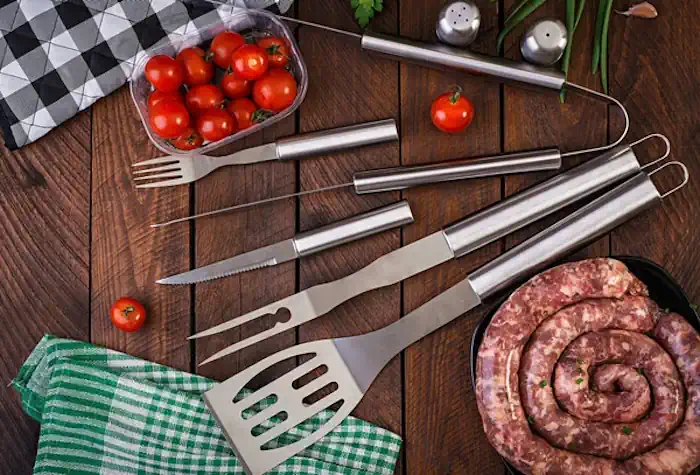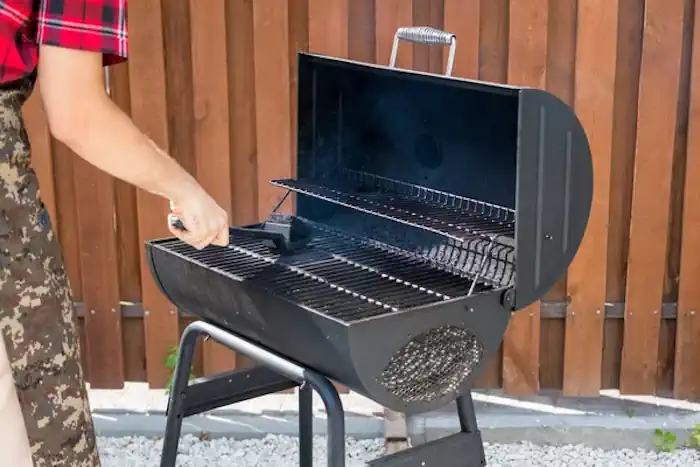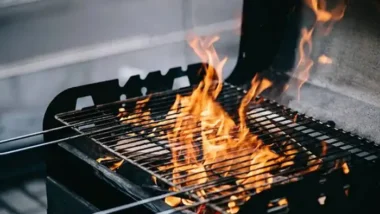If you’re like me, like a moth to a flame, you’re drawn to the tantalizing aroma of grilled food. But if you haven’t grilled before, don’t let the fear of the unknown char your dreams!
You’re about to embark on a sizzling journey into the world of grilling. With this starter kit, you’ll transform from a BBQ novice to a grill master in no time.
Whether it’s choosing the right grill or mastering top techniques, we’ve got you covered.
So, are you ready to fire up the fun?
Understanding Grilling Basics
The first step in your grilling journey is understanding the basics, so let’s dive right in.
It’s all about heat control. Whether you’re using gas or charcoal, grilling is a balancing act between heat intensity and cooking time. Too hot, and your food burns on the outside while staying raw inside. Not hot enough, and you’ll be waiting forever. You’ve got to find that sweet spot.
Your grill has hot spots, cooler areas, and everything in between. Learn to use them to your advantage. High heat is great for searing, and low, indirect heat is perfect for cooking thicker foods through, without charring them.
Practice makes perfect, so don’t be discouraged if your first few attempts aren’t flawless. Just keep at it. You’ll get the hang of it.
Essential BBQ Tools for Beginners
After grasping the fundamentals of heat control, your next step in the BBQ journey involves equipping yourself with the right tools—an essential aspect that can greatly enhance your grilling experience. Tools don’t simply serve a functional purpose—they can also affect the taste and overall quality of your BBQ.

Here’s a simple table featuring five essential BBQ tools every beginner should have:
| BBQ Tool | Purpose |
|---|---|
| Grill Tongs | Safely turning and moving food |
| Meat Thermometer | Ensuring meat is cooked properly |
| Grill Brush | Cleaning grill grates after use |
| Grill Spatula | Flipping burgers or fish |
| BBQ Gloves | Protecting hands from heat |
Choosing the Right Grill
Choosing the right grill isn’t just about picking the first shiny model you see. You’ve got to consider the type of grill that suits your cooking style, weigh up the balance between price and quality, and factor in practical elements such as size and portability.
It’s a decision that requires careful thought, but with the proper guidance, you’ll make the perfect choice for your BBQ needs.
Assessing Grill Types
First off, you’ll need to understand the three main types of grills to decide which one’s right for you. Here’s an easy-to-follow breakdown:
- Charcoal Grills: If you’re seeking that authentic, smoky flavor, this is your go-to. Charcoal grills take time to heat up, but the flavor payoff is worth it.
- Gas Grills: These are all about convenience. Gas grills heat up quickly, offer easy temperature control, and are simple to clean up.
- Electric Grills: Perfect for city dwellers with limited outdoor space. They’re safe to use indoors and require no fuel, just an outlet.
- Pellet Grills: A hybrid, these grills use wood pellets for heat and smoke, offering the flavor of a charcoal grill with the convenience of a gas one.
Choose wisely, your grill will become your trusty sidekick in mastering the BBQ.

Price Versus Quality
Now that you’ve got the four main types of grills in mind, it’s crucial to consider the balance between price and quality when selecting your ideal BBQ companion.
Don’t be tempted to go for the cheapest option, as you might end up with a grill that’s not durable or efficient. On the other hand, don’t assume that the most expensive grill will automatically be the best.
It’s all about finding the sweet spot where price meets quality. Look for grills with solid construction, durable materials, and a good warranty. Read reviews and do your research.
Size and Portability Considerations
Balancing price and quality, you’re also faced with considering size and portability when picking your ideal grill. It’s not just about finding a grill that cooks well; you need one fitting your lifestyle and space.
- Size: A compact grill is your best bet if you have a smaller patio or balcony. Large grills are great for big gatherings but require more space.
- Portability: For tailgating or camping, choose a lightweight, portable grill. Some even come with wheels for easy movement.
- Fuel Type: Charcoal grills are often more portable than gas grills, but they take longer to heat.
- Storage: Consider a grill with storage options for tools and spices if space is limited.
Choose wisely; your grill is an investment in many delicious meals to come.
Maintaining Your BBQ Equipment
Keeping your BBQ equipment clean and well-maintained will ensure you’re always ready for the next grilling session. Regular maintenance prevents buildup and prolongs the life of your tools. Don’t skimp on this step; it’s as important as mastering the perfect sear!
After each use, clean the grill grates with a wire brush. This removes any leftover food particles that could cause your BBQ to smoke excessively next time. Regularly empty the ash catcher, too, as accumulated ash can impact airflow and temperature control.

Once a year, give your BBQ a deep clean. This involves disassembling parts for thorough scrubbing and checking for signs of wear and tear. Remember, a well-kept BBQ is a well-performing one. Your taste buds will thank you.
Prioritizing Safety While Grilling
While grill maintenance plays a pivotal role in your BBQ experience, your safety protocol is an equally crucial component to master. You don’t want to be the one who turns a fun backyard cookout into an emergency situation.
- Always keep a fire extinguisher or a bucket of sand nearby. You never know when a flare-up might occur.
- Please don’t leave your grill unattended while it’s lit. It’s not just about the food; it’s about preventing potential accidents.
- Be mindful of your grill’s location. Keep it away from flammable materials and trees, and ensure it’s out of reach for kids and pets.
- Use long-handled utensils designed for grilling. It keeps you from getting too close to the flames.
When I first moved into my current neighborhood, the house 3 doors down was gutted by fire. They had been grilling on their small deck, with the grill close to the house, and had left the grill unattended. The next thing they knew, the back of the house was up in flames. And without a fire extinguisher nearby, the fire quickly spread to the entire house. Stay vigilant, respect the fire, and you’ll keep everyone safe.
Basic Cooking Techniques for Barbeque
Now that you’ve got safety under your belt, it’s time to dive into the core of barbequing: mastering basic cooking techniques.
First up, learn to control your fire. You’re aiming for a steady, medium heat – too hot and you’ll char your food; too cool and it won’t cook properly.
Next, understand the difference between direct and indirect grilling. Direct grilling is for quick-cooking items like burgers and vegetables, while indirect grilling is for larger, tougher cuts of meat that need slow, gentle cooking.
Lastly, practice flipping, not squishing, your food. Squishing releases precious juices and dries out your meal.
Final Thoughts
So, you’re ready to become a grill master, huh? With the right tools, a top-notch grill, and a dash of safety awareness, you’re set to serve up smoky, mouth-watering masterpieces.
Remember, maintaining your gear is as important as mastering those sizzling techniques.
So, fire up that grill, let the smoke rise, and let your grilling journey begin. With time and practice, you’ll be the star of every BBQ showdown.
Happy grilling!

